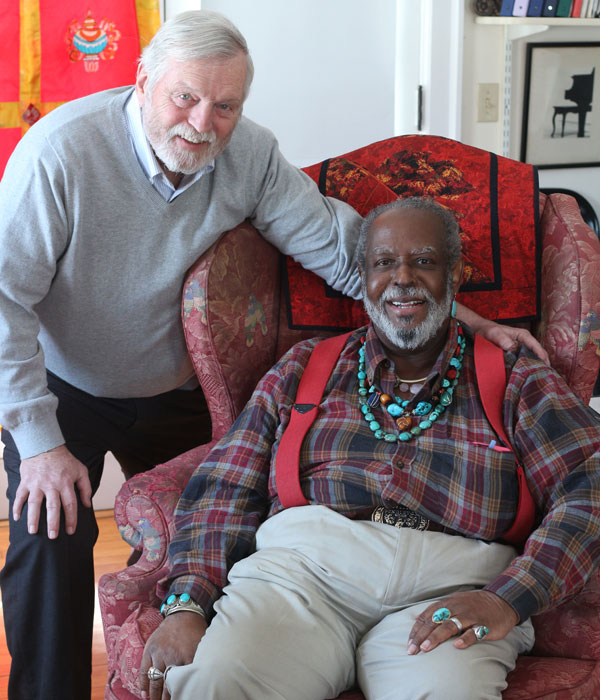François Clemmons and Karl Lindholm
In February 1968, the children’s television program “Mister Rogers’ Neighborhood” debuted nationally.
Besides its eponymous creator, the show also featured a cast of characters from Mister Rogers’ make-believe world (King Friday XIII, Daniel Striped Tiger, and Bob Dog), and his “real” world (Mr. and Mrs. McFeely, Lady Aberlin, and Handyman Negri).
 François Clemmons was cast in the “real” world as Officer Clemmons.
François Clemmons was cast in the “real” world as Officer Clemmons.
Fred Rogers met François in 1968 after hearing him sing in a Pittsburgh-area church they both attended. He was so impressed with his voice that he asked him to join the show. At the time, François was a graduate student working on getting his singing career going and was reluctant to accept Fred’s offer. But after realizing he would get paid to appear on the show—enabling him to afford his rent—François accepted, becoming the first African American actor to have a recurring role on a children’s television series.
For 25 years François appeared on the show while maintaining a separate career as a professional singer. In 1973, his performance with the Cleveland Orchestra earned him a Grammy Award and his love of spiritual music later led him to found the Harlem Spiritual Ensemble. He also spent 16 years as an artist-in-residence at Middlebury College in Vermont until his retirement in 2013.
François came to StoryCorps with his friend, Karl Lindholm (pictured together above), to discuss how he became the friendly singing Officer Clemmons, and his relationship with the man known to children as Mister Rogers.
Originally aired March 11, 2016, on NPR’s Morning Edition.
Diana Abath and Rick Abath
In the early morning hours of March 18, 1990, two thieves pulled off the biggest art heist in history.
Disguised as police officers, they tricked a night watchman into letting them into Boston’s Isabella Stewart Gardner Museum, and made off with artwork worth nearly half a billion dollars.
The thieves have never been caught and the art has never been recovered.
Rick Abath was the guard who opened the door that night. Twenty-five years after the robbery, he sat down to tell his story with his wife, Diana.
Originally aired March 13, 2015, on NPR’s Morning Edition.
Photo courtesy of the Boston Police Department.
Christopher Fraser and Victoria Fraser
When Christopher Fraser was 10 years old, he was left him with his grandparents who then raised him. At StoryCorps he talks with his grandmother, Victoria Fraser, about the adjustments he had to make to a new home, and how grateful he is for the many things she has done for him.
Originally aired October 17, 2008, on NPR’s Morning Edition.
Don Boniface and Ted Kuhar
Don Boniface (left) and Ted Kuhar (right) talk about how their relationship evolved over time. When they first met Don was living with AIDS and Ted had only recently told family and friends he was gay. Don remembers that at one point Ted looked him in the eyes and said, “you know, I won’t hang around for you if you get sick,” but that turned out not to be at all true.
Originally aired May 4, 2007, on NPR’s Morning Edition.
Jules Fishelman and Cathy Resmer
Jules Fishelman and Cathy Resmer discuss the time Cathy and her partner, Ann-Elise, asked Jules to be their sperm donor because as Cathy tells Jules, they felt he was “the kind of person that we want our child to grow into.”
Originally aired December 29, 2006, on NPR’s Morning Edition.
Sean Plasse and Blanche Podhajski
Sean Plasse talks with Blanche Podhajski about being dyslexic yet still graduating as his class valedictorian. Sean lived in fear that someone would realize how hard he was working to hide his dyslexia. “When you struggle with learning disability, it affects everything in your life.”
Originally aired November 3, 2006, on NPR’s Morning Edition.
Bobbi and Sandi Côté-Whitacre
Bobbi and Sandi Cote-Whitacre have been together for nearly 40 years.
The two met when they were very young. As Bobbi asked her partner recently, “Do you remember what it was like when we were 19 and totally in love—and couldn’t tell anyone?”
While the couple knew immediately that they would spend the rest of their lives together, the people around them weren’t so accepting.
 Originally aired October 6, 2006, on NPR’s Morning Edition.
Originally aired October 6, 2006, on NPR’s Morning Edition.
Remembering Kitty Genovese

On March 13th, 1964, one of one of the most infamous crimes in American history occurred in the Kew Gardens neighborhood of Queens, New York. At around 3 AM, 28-year-old Catherine “Kitty” Genovese was attacked, sexually assaulted, and murdered as she walked from her parked car. The assault lasted thirty-five minutes and occurred outside of an apartment building where a reported 38 witnesses either heard or saw the attack and did nothing to stop it. A front-page article in the New York Times sparked an avalanche of press and weeks of national soul searching. The case has lived on in plays, musicals, TV dramas — it even spawned a whole new branch of psychology.
Today the name Kitty Genovese remains synonymous with public apathy, although almost nothing is known of who she actually was. It was not reported in 1964 that Kitty Genovese was a lesbian and that she shared her home in Kew Gardens with her girlfriend, Mary Ann Zielonko. In this piece, the first broadcast interview she has ever granted, Mary Ann remembers Kitty and the time they shared.
Recorded in West Rutland, Vermont. Premiered March 13, 2004, on Weekend Edition Saturday.
This documentary comes from Sound Portraits Productions, a mission-driven independent production company that was created by Dave Isay in 1994. Sound Portraits was the predecessor to StoryCorps and was dedicated to telling stories that brought neglected American voices to a national audience.
